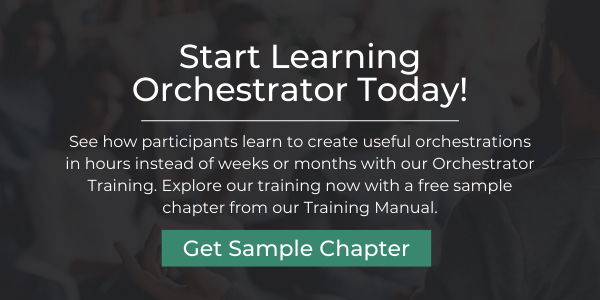Orchestrator Business Process Automation Use Cases for HR
Human Resources has made great strides in going digital with their administrative workflows. Still, there are hundreds of manual tasks that eat up HR’s time, hour by hour, even in a largely paperless environment. Andrew Ostdiek, Enterprise Software Manager at Hamilton Telecommunications, collaborated with ACBM on using the Orchestrator to recapture this time.
Three HR Problems Tackled. Dozens of Hours Saved.
Here is a quick overview of how Andrew’s company saved 72+ hours per year with a few simple orchestrations. We replaced manual tasks with accurate, timely, and consistent automated workflows that improved both productivity and work quality. After this, we’ll dig into details so you can see how it’s done.
- Batch Enrollment for Benefits
Non-mandatory benefit plans require manual updates of the eligibility dates for each employee to the first of the month prior to sending interface information to benefit vendors. The Orchestrator enables rules-based mass updates, making this a timely and consistent process that meets the requirements of benefits providers and prevents over/underinsuring employees.
Hours Saved Annually: 12+ - Removal of Direct Deposit Info
HR policy requires everyone to be paid via direct deposit. It’s crucial to remove sensitive banking information for ex-employees in a timely manner. Automating this process with the Orchestrator helps meet security and data privacy requirements without taking up any of HR’s time.
Hours Saved Annually: 10+ - Employee Terminations
With a workforce that experiences a high rate of turnover, employee master records must be updated routinely (biweekly) to stay current. Orchestrating this task eliminates missed or incomplete updates and ensures accuracy of the Employee Master data that downstream business processes and reports depend on.
Hours Saved Annually: 50+
Sample Business Process Automation Step by Step
Let’s take a look at the Employee Terminations use case to see the existing process and how it was replaced with orchestrations.
In the manual process, HR completed the following steps:
- Run R08720 and review list of Employees meeting criteria: • Pay Status = 9 (Terminated Last Check) • Pay Stop Date < 14 Days ago
- Access Work With Employee Information (P0801_W0801A) • Find & select employee record
- Update these Employee Master fields (P0801EMP_W0801EMPA) • Pay Status (T) Termination Date (MM/DD/YYYY) • Alternate Employee (blank) Date Pay Stops (blank)
- Update the Change Reason (P08EFT_W08EFTA) • Change Reason Code (I or V) Effective Date (MM/DD/YYYY)
- Access Work With Employee Information (P0801_W0801A) • Find & select employee record and click the ‘Organizational’ button
- From the Organizational Assignment screen (P0801ORG_W0801ORGA) • Select the ‘User Defined Dates 01-10’ Row Exit
- Update the following fields on (P0801ORG_W0801ORGC) • Date10 (blank)
- Update the Change Reason (P08EFT_W08EFTA) • Change Reason Code (I or V) Effective Date (MM/DD/YYYY)
- Select cancel to close Employee form (P0801EMP_W0801EMPA)
Here is the new process we built using the JD Edwards EnterpriseOne Orchestrator:
What used to be a nine step process now happens without human intervention.
What Lessons Did We Learn along the Way?
Every orchestration is an opportunity to learn how to do things better. Here are a few insights from building the termination orchestration.
- We created two orchestrations because we had to populate the pay status based on the change reason. This could have been solved with a cross reference instead of rules, but we would still need two orchestrations because we can’t iterate over the list of employees for multiple steps.
- It’s smartest to work backwards. Start with the form request that needs to update the data then figure out how to get/calculate the inputs you need.
- Provide an ‘audit’ mechanism for users to review, along with a translation document of what is happening with this automated business process.
Each New Use Case Adds to Time Saved
You can see more of the use cases for this client in the full presentation here.
For another HR client, we also automated:
- Adding/Updating Home Business Units
- Position Master Changes
- Update Employee Master
- Add and Attach Dependents and Beneficiaries
There are no doubt many more ways to streamline processes in HR. We’re excited to discover more.
Going Beyond Existing Tasks to Expand HR’s Capabilities
Another benefit of the Orchestrator is that it allows integration with tools outside JDE. This means HR can add new functionality by interfacing JDE data with third party tools. Andrew leveraged this capability to help HR integrate with a BI tool that improves quality control in their workforce. That’s a use case we can explore another day.
For now, remember that wherever the Orchestrator can help you do things better, we can help you figure it out faster. Learn more about our Orchestrator Training here.


